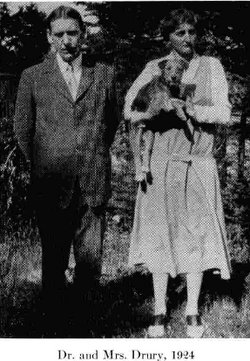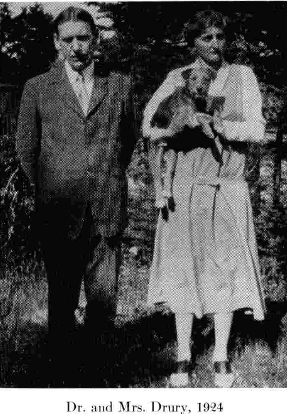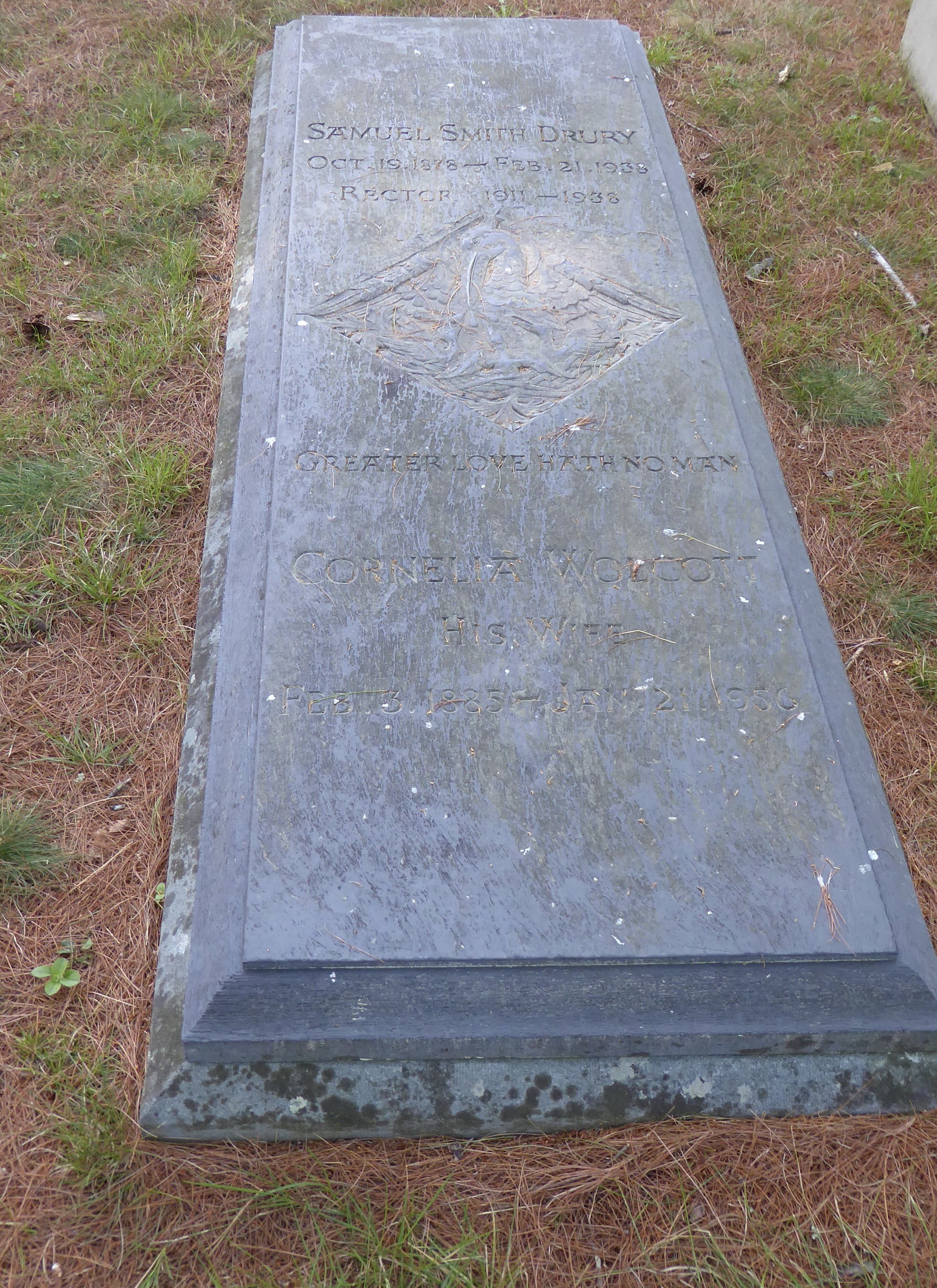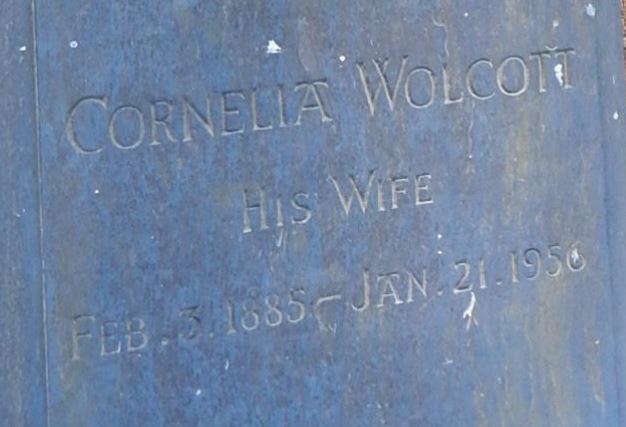The following summer, Dr. Drury having succeeded Dr. Ferguson as Rector on June 30th, the Rectory was painted white, and "wired" (it had not previously had electricity); and the Drurys moved in. They were to live at the Rectory-and in the summers in their house at North East Harbor - not quite twenty-seven years.
On February 21st, 1938, Dr. Drury, at the age of fifty-nine, died after an illness of but a few days.
Mrs. Drury then moved to Milton, and built a house on the place where she had lived as a child and as a young girl.
She died in Milton, January 21, 1956, survived by her three children, Samuel Smith Drury, Jr., Roger Wolcott Drury, and Edith Prescott Drury; and by six grandchildren, of whom one, Samuel Smith Drury, 3d.
The only daughter of Roger Wolcott, Governor of Massachusetts from 1896 to 1899, and of Edith Prescott Wolcott, she had grown up in Boston and in Milton, had graduated from Milton Academy, had spent a year abroad, and not long afterwards, at the house of one of her older brothers, had met Dr. Drury, then Rector of St. Stephen's Church.
Elected Vice Rector of St. Paul's School in October, 1909, Dr. Drury had gone to St. Paul's to live - at first, in the New Upper-the following April, and his engagement to Cornelia Wolcott had been announced in the late summer of 1910.
Mrs. Drury was well fitted for the life she was to live at St. Paul's. She had been brought up in a family of vigorous, lively boys-four brothers, three of them older than herself. She knew and loved country life, its occupations and its pleasures, as well as life in town.
She well understood the world, and was never shocked, never impressed, never patronizing. Her standards were high, and her judgments of others were generous and charitable.
Her attention to the sick, whether boys in the School or people who were neighbors, was characteristic of her, as were her interest in Coit House, and her very large share in the founding of the Community House and of Friendly House.
And suggested also in those letters are the constant thought, the self-effacing help, which she contributed throughout the whole of her twenty-seven years at the School. It is safe to say that in her time there was no phase of the School's life not known to her, no project, no problem, no sorrow. And those who were there in her time remember with emotion the vital strength and encouragement of her presence, the grace and vigor of her walk and her bearing, her warm humor, the poise of her head, the quiet but definite tone of her voice.
In a very true sense it may be said that she loved St. Paul's School, and that St. Paul's School was, and is, much the better place for her love of it.
The last years of her life were far from being an empty retirement.
She much enjoyed the house she had built in Milton, in surroundings familiar to her from childhood; and she fully employed her executive ability, and her capacity for intelligent sympathy, in the work of a number of organizations, among them the Church Home Society, of which she was president, the Boston Home for Incurables, many of whose applicants for admission she herself visited, and the Massachusetts General Hospital.
In the summer of 1953, an illness, a recurrence of which later caused her death, deprived her of the sight of one eye. She continued to drive her car with skill, to shovel snow from her walks in winter, to work in her garden, to rake and burn leaves in autumn; and her other work went on, too, along with a large correspondence.
She lived to be almost seventy-one, and her final illness was of but a few hours' duration.
[Bio by Connie Lagasse Russell
The following summer, Dr. Drury having succeeded Dr. Ferguson as Rector on June 30th, the Rectory was painted white, and "wired" (it had not previously had electricity); and the Drurys moved in. They were to live at the Rectory-and in the summers in their house at North East Harbor - not quite twenty-seven years.
On February 21st, 1938, Dr. Drury, at the age of fifty-nine, died after an illness of but a few days.
Mrs. Drury then moved to Milton, and built a house on the place where she had lived as a child and as a young girl.
She died in Milton, January 21, 1956, survived by her three children, Samuel Smith Drury, Jr., Roger Wolcott Drury, and Edith Prescott Drury; and by six grandchildren, of whom one, Samuel Smith Drury, 3d.
The only daughter of Roger Wolcott, Governor of Massachusetts from 1896 to 1899, and of Edith Prescott Wolcott, she had grown up in Boston and in Milton, had graduated from Milton Academy, had spent a year abroad, and not long afterwards, at the house of one of her older brothers, had met Dr. Drury, then Rector of St. Stephen's Church.
Elected Vice Rector of St. Paul's School in October, 1909, Dr. Drury had gone to St. Paul's to live - at first, in the New Upper-the following April, and his engagement to Cornelia Wolcott had been announced in the late summer of 1910.
Mrs. Drury was well fitted for the life she was to live at St. Paul's. She had been brought up in a family of vigorous, lively boys-four brothers, three of them older than herself. She knew and loved country life, its occupations and its pleasures, as well as life in town.
She well understood the world, and was never shocked, never impressed, never patronizing. Her standards were high, and her judgments of others were generous and charitable.
Her attention to the sick, whether boys in the School or people who were neighbors, was characteristic of her, as were her interest in Coit House, and her very large share in the founding of the Community House and of Friendly House.
And suggested also in those letters are the constant thought, the self-effacing help, which she contributed throughout the whole of her twenty-seven years at the School. It is safe to say that in her time there was no phase of the School's life not known to her, no project, no problem, no sorrow. And those who were there in her time remember with emotion the vital strength and encouragement of her presence, the grace and vigor of her walk and her bearing, her warm humor, the poise of her head, the quiet but definite tone of her voice.
In a very true sense it may be said that she loved St. Paul's School, and that St. Paul's School was, and is, much the better place for her love of it.
The last years of her life were far from being an empty retirement.
She much enjoyed the house she had built in Milton, in surroundings familiar to her from childhood; and she fully employed her executive ability, and her capacity for intelligent sympathy, in the work of a number of organizations, among them the Church Home Society, of which she was president, the Boston Home for Incurables, many of whose applicants for admission she herself visited, and the Massachusetts General Hospital.
In the summer of 1953, an illness, a recurrence of which later caused her death, deprived her of the sight of one eye. She continued to drive her car with skill, to shovel snow from her walks in winter, to work in her garden, to rake and burn leaves in autumn; and her other work went on, too, along with a large correspondence.
She lived to be almost seventy-one, and her final illness was of but a few hours' duration.
[Bio by Connie Lagasse Russell
Family Members
Sponsored by Ancestry
Advertisement
Advertisement


















